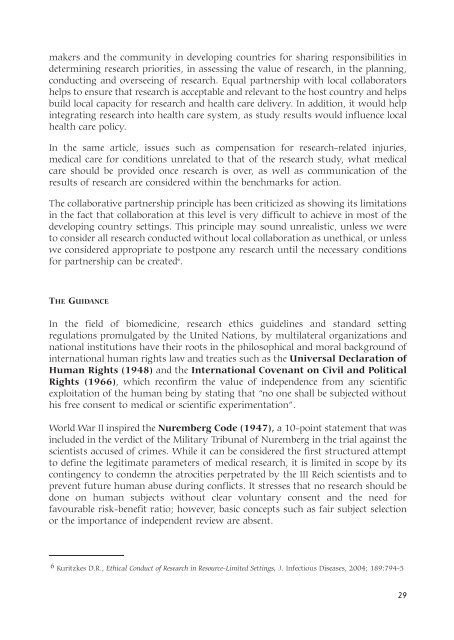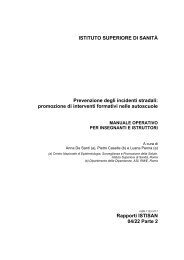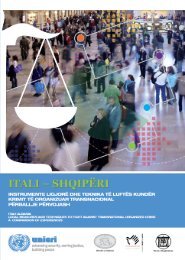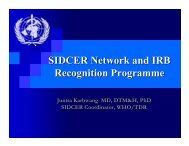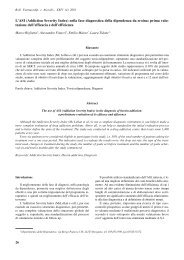Biomedical Research in Developing Countries - UNICRI
Biomedical Research in Developing Countries - UNICRI
Biomedical Research in Developing Countries - UNICRI
You also want an ePaper? Increase the reach of your titles
YUMPU automatically turns print PDFs into web optimized ePapers that Google loves.
makers and the community <strong>in</strong> develop<strong>in</strong>g countries for shar<strong>in</strong>g responsibilities <strong>in</strong><br />
determ<strong>in</strong><strong>in</strong>g research priorities, <strong>in</strong> assess<strong>in</strong>g the value of research, <strong>in</strong> the plann<strong>in</strong>g,<br />
conduct<strong>in</strong>g and oversee<strong>in</strong>g of research. Equal partnership with local collaborators<br />
helps to ensure that research is acceptable and relevant to the host country and helps<br />
build local capacity for research and health care delivery. In addition, it would help<br />
<strong>in</strong>tegrat<strong>in</strong>g research <strong>in</strong>to health care system, as study results would <strong>in</strong>fluence local<br />
health care policy.<br />
In the same article, issues such as compensation for research-related <strong>in</strong>juries,<br />
medical care for conditions unrelated to that of the research study, what medical<br />
care should be provided once research is over, as well as communication of the<br />
results of research are considered with<strong>in</strong> the benchmarks for action.<br />
The collaborative partnership pr<strong>in</strong>ciple has been criticized as show<strong>in</strong>g its limitations<br />
<strong>in</strong> the fact that collaboration at this level is very difficult to achieve <strong>in</strong> most of the<br />
develop<strong>in</strong>g country sett<strong>in</strong>gs. This pr<strong>in</strong>ciple may sound unrealistic, unless we were<br />
to consider all research conducted without local collaboration as unethical, or unless<br />
we considered appropriate to postpone any research until the necessary conditions<br />
for partnership can be created 6 .<br />
THE GUIDANCE<br />
In the field of biomedic<strong>in</strong>e, research ethics guidel<strong>in</strong>es and standard sett<strong>in</strong>g<br />
regulations promulgated by the United Nations, by multilateral organizations and<br />
national <strong>in</strong>stitutions have their roots <strong>in</strong> the philosophical and moral background of<br />
<strong>in</strong>ternational human rights law and treaties such as the Universal Declaration of<br />
Human Rights (1948) and the International Covenant on Civil and Political<br />
Rights (1966), which reconfirm the value of <strong>in</strong>dependence from any scientific<br />
exploitation of the human be<strong>in</strong>g by stat<strong>in</strong>g that “no one shall be subjected without<br />
his free consent to medical or scientific experimentation”.<br />
World War II <strong>in</strong>spired the Nuremberg Code (1947), a 10-po<strong>in</strong>t statement that was<br />
<strong>in</strong>cluded <strong>in</strong> the verdict of the Military Tribunal of Nuremberg <strong>in</strong> the trial aga<strong>in</strong>st the<br />
scientists accused of crimes. While it can be considered the first structured attempt<br />
to def<strong>in</strong>e the legitimate parameters of medical research, it is limited <strong>in</strong> scope by its<br />
cont<strong>in</strong>gency to condemn the atrocities perpetrated by the III Reich scientists and to<br />
prevent future human abuse dur<strong>in</strong>g conflicts. It stresses that no research should be<br />
done on human subjects without clear voluntary consent and the need for<br />
favourable risk-benefit ratio; however, basic concepts such as fair subject selection<br />
or the importance of <strong>in</strong>dependent review are absent.<br />
6 Kuritzkes D.R., Ethical Conduct of <strong>Research</strong> <strong>in</strong> Resource-Limited Sett<strong>in</strong>gs, J. Infectious Diseases, 2004; 189:794-5<br />
29


